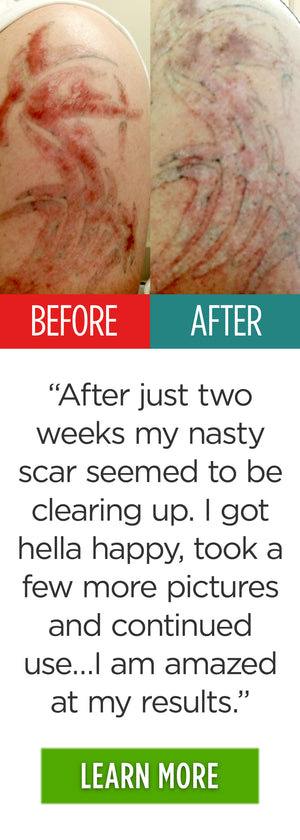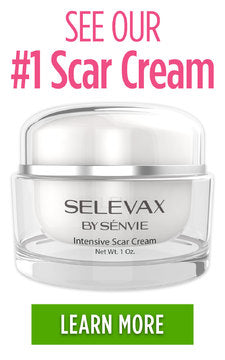How to Choose the Best OTC Scar Removal Cream
Posted on 22 January 2016 by Ning W
Share this post
With so many scar removal creams on the market, it’s important to choose the right one in order to get the results the product promises and you expect. But the over-the-counter landscape can be extremely confusing, and finding a formula that stands out from the rest can seem like an impossible challenge. Understanding the makeup of a scar – and how it happens – is the first information you should consider when selecting the best product.
Why Does Skin Scar?
Scars are caused when the collagen protein in skin forms abnormally after an injury to the middle layer, or dermis, of the skin. In response to the injury, the body forms new collagen proteins to repair the damage, much like a patch to cover a hole in a pair of jeans. Whether or not the repair looks natural or not depends on the amount of collagen fibers and how they form. Sometimes, the body produces too much collagen as part of the wound healing process, and a scar will be raised above the rest of your skin’s surface. These are called hypertrophic scars or keloid scars. When the injury to the skin is particularly deep, and results in structural damage beneath the dermis, the scar - usually surgical or acne scars - can be indented or pitted.
What Should You Look For in a Scar Cream?
According to the experts, the most beneficial scar creams contain silicone, which is effective because it helps maintain the moisture levels needed to protect new and existing skin cells. In a 2009 study from researchers in India that appeared in the Journal of Cutaneous and Aesthetic Surgery, scientists found that the topical use of silicone helped significantly improve the appearance of scars, including raised keloid scars, which are more difficult to treat, especially if they’ve been around for a while. Silicone works by creating a semipermeable layer over the surface of skin that traps moisture beneath it while still allowing essential oxygen to reach the skin. That layer not only preserves the moisture in skin – one of the essential components of scar healing, experts say – but also allows other ingredients such as antioxidants that specifically target skin proteins to hydrate skin more effectively, speeding the healing process. That means your first step in choosing a scar cream should include a scan of the label to determine if there is a silicone-based ingredients such as dimethicone, lanolin or mineral oil included in the formula. When skin is exposed to the right moisture and oxygen levels, it allows the healthy tissue surrounding scar tissue to better blend, encouraging the scar’s discoloration and texture to improve considerably. The only thing really shown to help the healing process and minimize scarring, Dr. Joseph Sobanko told the Los Angeles Times, is keeping a wound moist and covered. Silicone-based products do both.
Check Scar Cream Reviews
In order to make sure you’re not wasting your money, see what other people are saying about the scar cream you’re considering. Does the company website – or other neutral sites – offer real reviews from real users? If so, look for reviews that include information not only on product effectiveness, but also address how quickly the product works. Also, scan the ingredient list to see that experts have weighed in on specific ingredients, such as arnica oil, a natural botanical derived from a member of the daisy family which has been shown to help ease the discoloration of skin and help improve the healing process by increasing the flow of white blood cells to the area of a scar. “Most patients end up using the arnica gel if there is discoloration,” said Daniel Bigman, a physician assistant at New York Special Surgery Institute for Limb Lengthening & Complex Reconstruction, who also recommends vitamin E and silicone as successful, proven treatments for scars.
What Else Should You Look for in a Scar Cream?
If the reviews are solid and the ingredients are well-researched with history of healing, there are some other things to take into consideration before grabbing your credit card and making a purchase. Things to keep in mind:
- Can anyone use the cream you’re considering?
Make sure that the scar cream can be used on any and all types of scarring before making your purchase. Some won’t be effective on certain types of scars, while others are only well-suited for new scars. Make sure the product you are choosing is effective on old and new scars, and is safe to be used on raw, damaged skin.
- Are there before and after photos?
If you can see for yourself how well a scar removal cream works, you’ll have a better idea of what kind of improvements you might see when using the product yourself. Do the before and after pictures seem authentic, and do they include the types of scars you yourself are hoping to treat? If so, there’s a better chance that the cream will be effective for you and your scar as well.
- Make sure you are choosing a scar cream made in the United States.
Products made overseas might not follow the same rigorous testing that accompanies products manufactured in the U.S. The Food and Drug Administration rigorously regulates personal care products, especially so those that are focused on treating skin issues such as acne or scars. These products are treated as drugs, so the regulatory process is strict, better insuring user safety.
- Is there a money-back guarantee?
Many product manufacturers are willing to essentially put their money where their mouth is and offer you your money back if you’re not satisfied, even if you’ve used an entire jar of their product. If they do, it means they are confident that their product will work for you, and are willing to risk their own profit as proof.
Do Scar Creams Actually Work?
While some scars are likely permanent – stretch marks, for example, will fade away but will not disappear completely – the right scar creams can make a big difference in the appearance of even scars that have been around for a long time. Selevax, for example, has been shown to target acne scars, surgical scars, breast implant scars, burn scars, keloid scars and more. It is especially effective because it contains all-natural ingredients that are focused on healing and softening damaged skin, easing inflammation that can cause redness and increasing collagen and elastin proteins to restore your skin’s healthy look.






0 comments